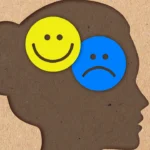When is Anxiety a Disorder?
Providing an accurate anxiety definition is difficult since everyone occasionally experiences feelings of stress and anxiety. There is a difference between having stress, fears and worries from time to time and experiencing a persistent set of symptoms that can accompany an anxiety disorder.
Some anxiety can be considered situational. This means your anxiety symptoms and feelings are specifically linked to a circumstance in your life. For example, you may feel anxious due to a heavy workload, parenting young children or facing a medical emergency.
Therapy.com is user supported. We receive a commission fee from purchases made through BetterHelp links.
Learn More
Situational anxiety is different from clinical anxiety which is defined by a persistent fear or worry that significantly interrupts your daily functioning. Unlike situational anxiety, clinical anxiety typically has a neurobiological origin. It arises from differences in the brain’s structure and functioning.
Mental health professionals use diagnostic criteria to determine if you fit the definition of clinical anxiety.
Prevalence of Anxiety Disorders and Demographics
Statistics suggest that anxiety disorders are among the most common mental health concerns. According to the National Institute of Mental Health:
- Around19.1% of adults (aged 18+) in the U.S. experience anxiety disorders in a given year.
- Women (23.4%) are more likely to experience anxiety than men (14.3%).
- Young adults aged 18 to 29 have the highest prevalence at 28%.
- Seniors between the ages of 60 and 69 have the lowest prevalence at 10%.
Common Anxiety Disorders
Generalized anxiety disorder (GAD) is a condition where you experience a persistent feeling of anxiety or dread that interferes with your everyday life. To receive this diagnosis, you must experience feelings of anxiety and worry more days than not for six months or more.
The feelings of anxiety will be associated with three or more of the following symptoms:
- Restlessness or feeling on edge
- Fatigue
- Difficulty concentrating
- Increased irritability
- Muscle tension
- Sleep disturbance
Social anxiety disorder is another form of clinical anxiety. It’s more than just a general feeling of shyness in public. This condition is marked by an intense and persistent fear of social situations where you may be judged or scrutinized by others.
This fear will lead to impaired functioning because of the unpleasant and severe symptoms that arise when you’re in a social situation. Symptoms can be so severe that they cause you to avoid social situations altogether.
This can lead to significant harms to your social, emotional, physical and financial wellbeing. Your academic and professional life may be impacted and your relationships may suffer.
Separation anxiety is a condition where you feel intense distress when separated from a loved one. You may experience some of the following:
- Excessive worry about harm coming to loved ones
- Fear of being alone
- Difficulty sleeping when away from loved ones
- Reluctance to go to school or other activities that involve separation
Panic disorder is a condition in which you experience recurring panic attacks. These attacks are usually a brief period of intense fear or discomfort marked by some of the following:
- A feeling of being out of control
- fear of death or feeling of impending doom
- Unpleasant physical sensations
- Racing thoughts
If you have panic disorder, you often develop an intense worry about when the next panic attack will happen. You may begin to fear or avoid places where panic attacks have occurred in the past.
Signs and Symptoms of Anxiety: Recognizing the Warning Signs
Anxiety symptoms can show up in a variety of ways, including psychical, cognitive and behavioral symptoms.
Physical symptoms of anxiety include:
- Heart palpitations or increased heart rate
- Sweating
- Trembling
- Tingly hands and feet
- Trouble breathing
- Dry mouth
- Dizziness or feeling weak
Therapy.com is user supported. We receive a commission fee from purchases made through BetterHelp links.
Learn More
Cognitive symptoms of anxiety include:
- Racing thoughts
- Excessive worry
- Catastrophizing
- Uneasy feeling of panic or danger
- Inability to concentrate
Behavioral signs of anxiety include:
- Avoidance
- Restlessness
- Irritability
- Trouble sleeping
Certain symptoms are specific to different anxiety disorders and across age groups.For generalized anxiety disorder (GAD), some signs to look for include:
- Excessive worry about everyday things
- Trouble controlling worries or feelings of nervousness
- Feeling restless and having trouble relaxing
- Trouble falling asleep or staying asleep
- Having headaches, muscle aches, stomachaches or unexplained pains
- Feeling irritable or “on edge”
Children and teens with GAD often worry excessively about:
- Their performance in activities such as school or sports
- Catastrophes such as earthquakes or war
- The health of others, such as family members
Adults with GAD are often highly nervous about everyday circumstances, such as:
- Job security or performance
- Health
- Finances
- The health and well-being of their children or other family members
- Being late
- Completing household chores and other responsibilities
Social anxiety comes with its own set of symptoms that may include:
- Blushing, sweating, or trembling
- Rapid heart rate
- Nausea
- Difficulty making eye contact or speaking to people they do not know
- Feeling self-consciousness or fear that people will judge them negatively
Panic Disorder vs. Anxiety Disorders
Panic disorder is mostly marked by the physical symptoms experienced during a panic attack. During a “panic attack” you may experience:
- Pounding or racing heart
- Sweating
- Chills
- Trembling
- Shortness of breath
- Weakness or dizziness
- Tingly or numb hands
- Chest pain
- Stomach pain or nausea
Anxiety attack symptoms are very similar to panic attack symptoms but with some marked differences.
Anxiety attacks often build up more slowly over time and are often a result of a specific anxiety-inducing situation. They may be slightly less intense than panic attacks but they often last longer.
Panic attacks come on suddenly, do not last very long, and have intense physical symptoms as listed above. They also often come on unexpectedly and with no known trigger.
When Should I Seek Help?
If you are regularly experiencing some of the symptoms of anxiety and it is interfering with your performance at work or school and causing problems in relationships and social interactions, then you should seek professional help.
Tell your doctor about your symptoms or search for mental health providers in your area to get a professional opinion on what treatment will be best for you.
Therapy.com is user supported. We receive a commission fee from purchases made through BetterHelp links.
Learn More
Clinicians have a range of tools to assess your condition, determine if you have an anxiety disorder, identify its type and formulate an effective treatment plan.
Your doctor may use a common questionnaire, in addition to performing a clinical interview, to help make a diagnosis of anxiety.
One commonly used questionnaire that can help determine if you have an anxiety disorder is called the Generalized Anxiety Disorder Questionnaire (GAD-7).
What Causes Anxiety? Understanding the Origins
Researchers are not sure what the exact causes of anxiety are and where they originate, although some factors may increase your risk of having an anxiety disorder. These include:
- Family history of anxiety or other mental health conditions
- Brain chemistry imbalances
- Traumatic experiences
- Stressful life events
- Isolation
- Substance misuse
If you have a family history of anxiety, this could point to some genetic factors influencing your anxiety symptoms. Genetics may impact brain structures and neurotransmitter functioning which can contribute to anxiety disorders.
Being exposed to certain patterns of behavior and thinking from a family member with anxiety can also lead to learned patterns for yourself.
For example, if you grew up with a parent who talked about their persistent worries and fears and avoided social situations, you may find yourself falling into similar patterns as well.
A difficult reality about anxiety disorders is that the cycle often perpetuates itself. You experience unpleasant symptoms and excessive worry about a situation and hope to never feel this way again.
This leads to anxiety about feeling anxiety again and so a self-perpetuating cycle is born.
Fortunately treatment can help to interrupt this anxiety cycle and restore the peaceful and optimistic life you deserve.
Therapy.com is user supported. We receive a commission fee from purchases made through BetterHelp links.
Learn More
FAQs
Normal stress will be alleviated after the event that has brought the stress on is over. Anxiety disorders persist beyond circumstances. Also, normal stress should not interfere with your ability to function normally in your everyday activities. Anxiety disorders often disrupt work, school and relationships.
Many anxiety medication options are not addictive including SSRIs, SNRIs, and beta blockers. Benzodiazepines are sometimes used to treat anxiety and can become addictive if taken regularly for a long period.
You should discuss any medication concerns you have with your doctor to find the right solution for you. Many people choose to take anxiety medication long term but others use it for a limited period of time to help cope with symptoms while clients stabilize. Therapy can help clients understand their disorder and learn new anxiety management techniques.
Many people struggle with feeling shy or introverted in social situations. In fact, public speaking is listed as the number one fear for people around the world.
Social anxiety disorder is more than just an ordinary fear of social situations or typical anxiety producing situations. Social anxiety disorder is marked by intense and persistent fear of others judging you in ordinary social situations and common daily interactions with others.
This condition leads to uncomfortable symptoms in social situations or a total avoidance of social interactions.
Treatments vary from person to person, and the timeframe of how and when it will improve symptoms also varies. Many medications can take up to six weeks before patients notice a difference in symptoms. Psychotherapy can sometimes provide immediate relief in the form of learning coping skills to manage symptoms.
Anxiety is often connected with physical health problems. Chronic stress can increase your risk for heart disease, hypertension, digestive issues and chronic pain. Anxiety often causes sleep disturbances as well, which greatly impacts physical health.
Yes, children can have anxiety disorders, although GAD is most common among adults.
Separation anxiety can be a normal development stage for young children up to the age of 5. However your child might be diagnosed with separation anxiety disorder if the symptoms are severe enough.
Signs of separation anxiety include:
- Clinging to parents or other caregivers
- Tantrums when separated from parents or caregivers
- Refusing to sleep alone
- Refusing to go to school or other activities without a parent
- Avoiding sleepovers or parties
- Difficulty concentrating at school
Living Well with Anxiety: Self-Management Strategies
There are several ways you can begin to manage your anxiety by making some lifestyle adjustments.
Here are some tools you can begin to introduce into your daily routine:
- Prioritize at least 8 hours of sleep at night
- Maintain a nutritious diet
- Plan for some physical movement every day
- Try mindfulness and meditation exercises
- Practice breathing exercises and grounding techniques for panic attacks
- Talk with others about your feelings
- Set health boundaries in relationships
- Challenge negative self talk and increase positive self affirmations
Self care is a term that refers to activities and habits that improve your quality of life. You can practice self care in many ways, including:
- Scheduling regular breaks throughout your day for yourself
- Eating a snack
- Taking a walk
- Playing music that calms you
- Taking a nap
- Taking a bath or shower
- Engaging in regular skincare routines
- Reading a book
While self-management strategies are important, there are also professional treatment options that give you the best chance at managing an anxiety disorder.
Anxiety Treatment Options: Finding the Right Approach
Treatment options for anxiety often include a combination of psychotherapy and medication.
There are several evidence-based psychotherapy approaches used to treat anxiety, including cognitive behavioral therapy (CBT) and exposure and response prevention (ERP).
Therapy.com is user supported. We receive a commission fee from purchases made through BetterHelp links.
Learn More
CBT is an approach that focuses on restructuring our thought patterns to affect our emotions and behaviors. Some of the techniques used in CBT include:
- Thought stopping
- Positive self-talk and affirmations
- Identifying cognitive distortions
- Relaxation exercises
- Self-monitoring to identify patterns
ERP is a therapy specifically used to address a type of anxiety disorder called obsessive-compulsive disorder (OCD). It has two components.
If you suffer from a specific phobia that has led to an obsession, such as a fear of heights or flying, then your practitioner will use exposure therapy to gradually expose and desensitize you to that phobia.
The response prevention part of ERP helps address compulsions that can occur as a result of your obsessions. It’s focused on breaking the cycle between what you experience and how you respond.
Therapy is offered in a variety of mediums, including telehealth and online platforms. These options often benefit patients suffering from anxiety as it allows you to engage in treatment from the comfort of your own home.
In many cases, the most effective treatment approach is to combine medication with psychotherapy. Some may choose not to involve medication, but most professionals will strongly encourage therapy to be part of the treatment plan regardless of medication.
Anxiety medication options include:
- Selective serotonin reuptake inhibitors (SSRIs), which increase the availability of serotonin in the brain to help regulate anxiety
- Serotonin-norepinephrine reuptake inhibitors (SNRIs), which increase the levels of serotonin and norepinephrine in the brain
- Benzodiazepines, which are depressants that affect a neurotransmitter called GABA to regulate anxiety and have sleep-inducing effects along with anti-seizure and muscle relaxing properties
It’s important to understand that benzodiazepines have the potential for dependence. They’re best used in time-limited situations such as treating flight anxiety or social anxiety.
For clients with generalized anxiety disorder who experience daily symptoms, they’re not typically considered a first-line treatment.
Finding a comprehensive treatment plan and a treatment provider that is right for you can seem like a daunting task.
Start by speaking to your doctor about your concerns and any interest you have in medications.
You can also ask your doctor for referrals for mental health professionals who can provide therapeutic services. If you have insurance, take a look at behavioral health providers covered under your plan.
Therapy.com is user supported. We receive a commission fee from purchases made through BetterHelp links.
Learn More



